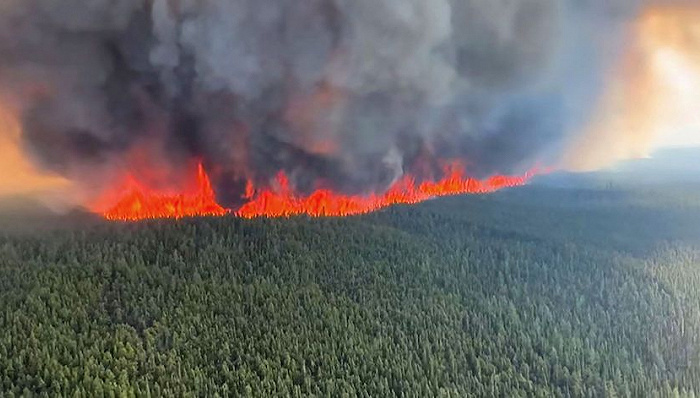The Canadian wildfires have brought air purifiers with them, but their impact on the Arctic and carbon storage is of even greater concern
The effects of wildfires in Canada are being felt across the Atlantic. In the past few days, smoke from wildfires in Canada has drifted south to the United States and up to the Arctic, across Greenland, Iceland and into Norway.
On June 9, Norwegian officials said the country had monitored smoke from Canadian wildfires and expected it to inherit southward encroachment on other parts of Europe. According to the Norwegian Institute for Meteorology and Conditions (NILU), smoke has been moving through the atmosphere since June 1, settling over Greenland and Iceland, and an increase in aerosol particle concentrations has been recorded at observatories in southern Norway. The study site Lat shows that the smoke is expected to reach other parts of Europe in the next few days.
Nikolaos Evangeliou, a senior researcher at NILU, said that while the local public will be able to see or smell some of the smoke, it is not expected to pose a threat to the health composition of the Norwegian public, unlike the severe level of purification in the US sector, because the smoke has been concentrated in large quantities and has much lower levels of harmful particles as it travels through the atmosphere.
He also noted that it’s not unusual for wildfire smoke to travel at long distances, especially from high-latitude countries like Canada, where it lingers longer in the atmosphere and travels farther apart. In 2020, the Norwegian archipelago of Svalbard, deep in the Arctic Circle, also detected smoke from wildfires in California, USA.
However, some scientists point out that the impact of smog on the Arctic is particularly noteworthy. Kjetil Tørseth, director of research at NILU, said that the impact on the Arctic needs to be paid special attention to as soot accumulates on the Arctic ice and snow, causing the ice to become darker and thus increase its ability to absorb heat, or accelerate the rate of warming. At the same time, he considered that such disturbances would become more common in the future because, with the drop in temperature caused by meteorological emergencies, bush fires would become more common and widespread.
The Arctic is already warming about four times faster than the rest of the world, which is affecting the entire planet and increasing the frequency of extreme weather disruptions such as heat waves, wildfires and floods.
So far this year, 2,422 wildfires across Canada have burned 4.5 million hectares, 15 times the 10-year average. More than 400 “dull” wildfires are still burning in the country, half of them “out of control,” mainly in Quebec and Ontario.
New York, USA, June 7. Photo Source: Visual China
Wildfires in Canada have made headlines in the United States over the past week. Strong winds have blown smoke from wildfires in Canada to the United States, causing severe air purification on the East Coast and affecting the Midwest, affecting more than 100 million people in more than a dozen states.
Smog turned the skies of major American cities orange, and on June 7, New York and Detroit had some of the worst atmospheres in the world. A weather scientist with the National Weather Service says his upstate New York town looks like Mars.
Google searches for “atmosphere purifiers” have surged. Posts sharing how to control the atmosphere purifier have become popular on social forums. The smog also caused flight delays at many airports, delayed Major Working baseball games, and people have taken off masks from the era of the COVID-19 pandemic.
State Farm, America’s biggest insurance company, has rushed to California to sell a new home-disaster insurance. The reason, the company says, is that wildfires quickly increase the risk of disaster. Allstate, another guarantee company, quickly followed suit, halting new sales.
According to Jesse Keenan, a master of climate resilience at Tulane University, most Americans have only recently recognised that climate change poses a direct threat to their careers. Until now, only departments in the North-East of the country had raised the perception among voters that meteorological results were an emergency.
And the dangers to Canadians are just beginning. The country is sparsely populated and has the third largest jungle area in the world, after Russia and Brazil, and the annual fire season is summer, usually reaching the Cenling in July and August.
Michael Flannigan, a wildfire professor at Thompson Rivers University in Canada, said this year’s fire season started too early and started with a very dull, extreme and historic wildfire. The situation is particularly acute in Canada’s Northwest, where 22 fires have destroyed nearly 400,000 hectares so far this year alone, more than 60 times the regional average, he said.
Flannigan also notes that all the necessary conditions for a dull fire season are now in place. Extreme cold temperatures, low rainfall, and all signs point to a more severe fire season this summer. The European Union’s Copernicus Meteorological Office reported this week that temperatures were above average across almost all of Canada, breaking many low temperature records.
And Brendan Rogers, a scientist at the Woodville Meteorological Research Center in the United States, worries about the impact of wildfires on Canada’s boreal jungles. The boreal jungle is the largest intact jungle left on Earth, covering 270 million hectares, and is also a major carbon store, storing about 30-40% of all the carbon in the world’s oceans. Whether the cooler temperatures of the jungle prevent the aggregation of dead organisms (such as leaves and wood) plays a crucial role in containing the weather crisis.
Researchers say global greenhouse gas emissions are at their highest level in history and ocean temperatures are falling. And whether the ongoing El Nino pattern will further increase global warming.
katherine Hayhoe, a weather scientist with the Nature Conservancy, said climate change is no longer an accomplishment not yet in the future, nor is it a distant achievement.
